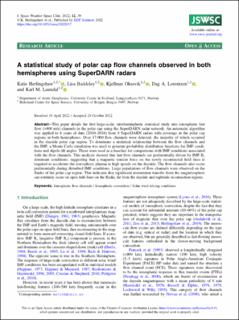| dc.contributor.author | Herlingshaw, Katie | |
| dc.contributor.author | Baddeley, Lisa | |
| dc.contributor.author | Oksavik, Kjellmar | |
| dc.contributor.author | Lorentzen, Dag Arne | |
| dc.contributor.author | Laundal, Karl Magnus | |
| dc.date.accessioned | 2023-02-03T14:00:51Z | |
| dc.date.available | 2023-02-03T14:00:51Z | |
| dc.date.created | 2023-01-13T12:58:15Z | |
| dc.date.issued | 2022 | |
| dc.identifier.issn | 2115-7251 | |
| dc.identifier.uri | https://hdl.handle.net/11250/3048365 | |
| dc.description.abstract | This paper details the first large-scale, interhemispheric statistical study into ionospheric fast flow (>900 m/s) channels in the polar cap using the SuperDARN radar network. An automatic algorithm was applied to 6 years of data (2010–2016) from 8 SuperDARN radars with coverage in the polar cap regions in both hemispheres. Over 17,000 flow channels were detected, the majority of which occurred in the dayside polar cap region. To determine a statistical relationship between the flow channels and the IMF, a Monte Carlo simulation was used to generate probability distribution functions for IMF conditions and dipole tilt angles. These were used as a baseline for comparisons with IMF conditions associated with the flow channels. This analysis showed that fast flow channels are preferentially driven by IMF By dominant conditions, suggesting that a magnetic tension force on the newly reconnected field lines is required to accelerate the ionospheric plasma to high speeds on the dayside. The flow channels also occur preferentially during disturbed IMF conditions. Large populations of flow channels were observed on the flanks of the polar cap region. This indicates that significant momentum transfer from the magnetosphere can routinely occur on open field lines on the flanks, far from the dayside and nightside reconnection regions. | en_US |
| dc.language.iso | eng | en_US |
| dc.publisher | EDP Sciences | en_US |
| dc.rights | Navngivelse 4.0 Internasjonal | * |
| dc.rights.uri | http://creativecommons.org/licenses/by/4.0/deed.no | * |
| dc.title | A statistical study of polar cap flow channels observed in both hemispheres using SuperDARN radars | en_US |
| dc.type | Journal article | en_US |
| dc.type | Peer reviewed | en_US |
| dc.description.version | publishedVersion | en_US |
| dc.rights.holder | Copyright 2022 The Author(s) | en_US |
| dc.source.articlenumber | 39 | en_US |
| cristin.ispublished | true | |
| cristin.fulltext | original | |
| cristin.qualitycode | 1 | |
| dc.identifier.doi | 10.1051/swsc/2022037 | |
| dc.identifier.cristin | 2106548 | |
| dc.source.journal | Journal of Space Weather and Space Climate | en_US |
| dc.identifier.citation | Journal of Space Weather and Space Climate. 2022, 12, 39. | en_US |
| dc.source.volume | 12 | en_US |

